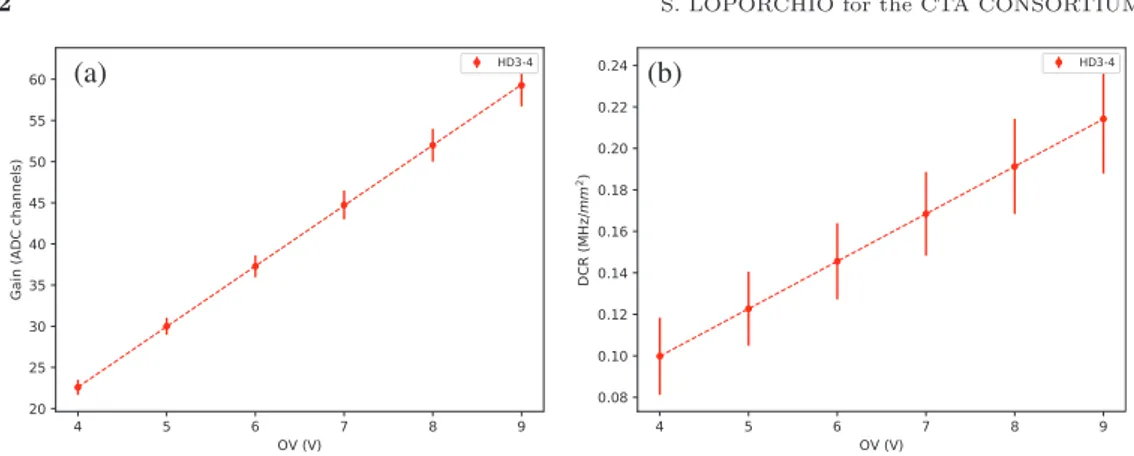DOI 10.1393/ncc/i2020-20080-9 Colloquia: IFAE 2019
IL NUOVO CIMENTO 43 C (2020) 80
Characterization of FBK SiPM arrays for the SCT medium size
telescope prototype proposed for the CTA observatory
S. Loporchio(1)(2)(∗) for the CTA Consortium(∗∗)
(1) INFN, Sezione di Bari - Bari, Italy
(2) Dipartimento Interateneo di Fisica, Universit`a e Politecnico di Bari - Bari, Italy received 8 June 2020
Summary. — The Cherenkov Telescope Array (CTA) will represent the new gen-eration of Imaging Atmospheric Cherenkov Telescopes (IACTs), aimed to detect very high-energy gamma-rays produced in atmospheric showers. The prototype Schwarzschild-Couder Telescope (pSCT) has been inaugurated in January 2019 at the Fred Lawrence Whipple Observatory aiming to the extension of the CTA ar-ray baseline. Silicon Photomultipliers (SiPMs) are particularly suitable as optical units of IACTs to detect the low- and fast-intensity Cherenkov signal. The Near UltraViolet High-Density 6× 6 mm2 SiPMs (NUV-HD3), produced by Fondazione Bruno Kessler in collaboration with INFN, have been assembled in more than 100 arrays of 16 pixels. These optical modules have been characterized in the labo-ratories of INFN to be integrated on the camera of pSCT. In this contribution we report the characterization results of the SiPM arrays and on the uniformity of their performances.
1. – The Schwarzschild-Couder Telescope prototype camera
The prototype of the Schwarzschild-Couder Telescope for the Cherenkov Telescope Ar-ray observatory has been inaugurated on 17 January 2019 at the Fred Lawrence Whipple Observatory in Arizona. The focal plane of the telescope will consist of 11382 SiPM pix-els arranged in 177 modules. Each module hosts 16 pixpix-els optical units arranged in 4× 4 matrices of 6× 6 mm2 SiPMs, with dedicated FEE for signal sampling and digitization based on the TARGET-7 ASIC. A first section of 25 modules has been installed in 2018; the INFN in collaboration with Fondazione Bruno Kessler (FBK) developed 9 of these modules, which have been equipped with FBK NUV-HD3 SiPMs.
(∗) E-mail: [email protected]
(∗∗) http://www.cta-observatory.org/consortiumauthors/authors 2019 06.html.
2 S. LOPORCHIO for the CTA CONSORTIUM
(a) (b)
Fig. 1. – (a) Average value of gain and (b) DCR as a function of the applied overvoltage.
2. – Electric tests of 16-pixel optical units
More than 100 matrices of HD3 SiPMs have been assembled and characterized in INFN laboratories. Three productions of SiPMs, HD3-2, HD3-3 and HD3-4, which differ in the quality of the Si substrate, have been characterized during pSCT test campaigns. After the assembly, IV curves of the 16 pixels were acquired for each matrix in order to estimate the breakdown voltage for each pixel with the procedure described in [1].
3. – Uniformity of performances
All matrices were characterized with an ad hoc readout electronics for signal amplifica-tion and pole-zero cancellaamplifica-tion [2] and a charge-to-digital converter (CAEN V792 QDC). Each sensor was placed in a dark box and illuminated with a 380 nm Pulse Diode Laser, increasing the bias voltage between 31 V and 36 V. Charge distributions were acquired and fitted with a multiGaussian function, from which parameters gain and Signal-to-Noise Ratio (SNR) were acquired. The trend of the gain for the first photo-electron (p.e.) as a function of the overvoltage (VOV= VBIAS− VBD) for all the tested pixels was
fitted with a linear function, estimating the gain per voltage unit for each pixels. The average gain for a certain overvoltage value was evaluated from the estimated parame-ters, as shown in fig. 1(a). SiPMs signals were also acquired in dark conditions in order to evaluate the Dark Count Rate (DCR) for each pixel. DCR curves were also fitted in order to evaluate the DCR trend as a function of the overvoltage, as shown in fig. 1(b).
4. – Conclusions
The measurements here reported for HD3-4 matrices have been carried on for the three NUV-HD3 SiPM production. The mean value of gain per overvoltage distribution for HD3-4 pixels is 7.37± 0.36 ADC channels per V. Due to its better performance in terms of gain, SNR and DCR, HD3-4 production has been chosen to equip the camera. Among the HD3-4 matrices tested, 36 have been chosen based on the uniformity of their measured parameters and have been coupled to the front-end electronics module, and finally integrated on the pSCT camera, which is currently in commissioning.
CHARACTERIZATION OF FBK SiPM ARRAYS ETC. 3
REFERENCES
[1] Otte N. et al., Nucl. Instrum. Methods A, 846 (2017) 106. [2] Ambrosi G. et al., Nucl. Part. Phys. Proc., 291-293 (2016) 55.
